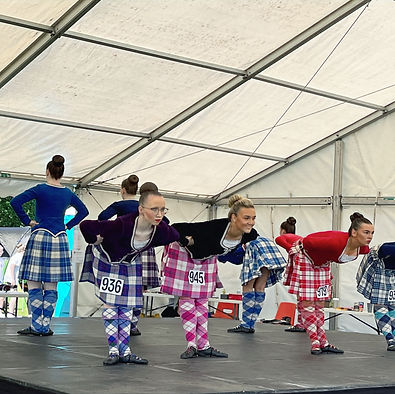Highland Dancing Competitions
In Layman's Terms

HIGHLAND DANCING
STEALS THE SHOW
Highland Dancing showcases our gorgeous national costumes and serves up a lively display of physical fitness. As a competitive and technical dance form,
it requires technique, stamina, and strength.
Highland dances have fascinating origins, like celebrating battle victories and rural legends.
Highland Dancing used to be male-dominated; now,
it's mainly the ladies that rule the dance floor.
Highland Dancing
Basic Rules
-
At the Helensburgh and Lomond Highland Games, dancers must live in Argyle and Bute.
-
In Highland Dancing competitions, dancers are ranked into five groups based on their experience and achievements:
-
Primary: Under 7 years of age.
-
Beginner: Until winning 6 different contests.
-
Novice: Until winning 6 or more competitions.
-
Advanced Intermediate: For one year after the last Novice competition.
-
Open and Premier: The top tiers, with age classifications within each group.
-
-
Judges consider a dancer's rhythm, technique and posture when evaluating Highland dancers in competition. Dancers must synchronize their movements with the music’s rhythm and convey the dance’s energy and emotion. They must pay attention to footwork, arm positions, and head movements. All the while maintaining good posture, grace, smiling and making the dance look effortless and natural. These three elements help give a dancer a significant advantage in a competition.
-
Female dancers wear a velvet jacket with gold or silver braid edging and gold or silver buttons over a white shirt with lace ruffles at the neck. They wear a kilt, tartan hose (socks), black laced gillies, or dancing shoes. For dances like the hornpipe, a costume appropriate to the dance is worn.
-
Male dancers wear kilt, a sporran, a jacket and bonnet, a tartan hose, and a sgian dhubh (pronounced 'ski-en doo'), which is a small single-edged knife.
_edited.jpg)
Pas de basque & Highcuts
The pas de basque is one of the first movements
a dancer learns and is a dance in itself only in the primary section.
High Cuts should be danced on the ball of the foot
and on the one spot.
Sword Dance
The specific dance itself is believed to date to King Malcolm III of Canmore. After killing one of Macbeth’s chieftains in mortal combat at the Battle of Dunsinane in 1054, he was said to have taken his opponent's sword, crossed it with his own still bloody claymore on the ground, symbolising the sign of the cross and danced over them in exaltation. For centuries, the dance was used to relieve tension before battle. Men had to exhibit great self-control because if the swords were touched whilst dancing, defeat in the battle was predicted.


Highland Fling
The Highland Fling is probably the oldest of Scotland’s traditional dances. It symbolizes victory following a battle. Warriors performed the Fling around a small round shield called a “targe.” These targes often had a sharp steel spike at the centre, so dancers had to move with skill and dexterity.
Another interpretation links the dance to successful stag hunts. The dancer’s upraised arms and hands are said to mimic the antlers of a deer.
Sean Triubhas
In Gaelic, it’s pronounced “shawn trewus,” which translates to “old trousers” in English. This dance carries a romantic association with Scottish history during the period from 1746 to 1782. After the Battle of Culloden Moor, where Bonnie Prince Charlie was defeated by the English armies, the Scots were prohibited from wearing their ancient Highland Dress. Instead, they had to endure the despised Sassenach trousers.
The dance unfolds in two parts:
-
The initial slow, flowing movements mock the uncomfortable trousers, as the Highlander tries to shake and kick off the offending garments.
-
The second part, a lively reel, portrays the dancer once again feeling free in traditional attire. The quick, haughty hand movements symbolize both the hatred of repression and the liberation from oppressive clothing and bondage.


Half Tulloch
It is believed that this reel originated in the churchyard of Tulloch, Aberdeenshire.
It is said that on a chilly winter Sunday, a tardy minister caused parishioners to huddle together, whistling a highland tune, clapping their hands and stamping their feet to stay warm. Thus, this lively dance was born. Although the dancers dance together they are not judged as a team but individually.

Hornpipe
The Hornpipe originated as a solo dance among sailors in the 17th century. Sailors aboard ships for extended periods used the Hornpipe, with its lively steps, as a way to keep them physically active and alleviate boredom,
The dance vividly recreates a sailor’s shipboard tasks: hauling ropes, hoisting sails, scanning the horizon, and waving farewell flags. During the break, the distinctive “step-close” signifies the sailor crisply stepping forward to receive his pay.
When you next see the Hornpipe danced, imagine sailors dancing across rolling decks, their spirits lifted by the rhythm of the sea.
